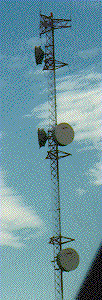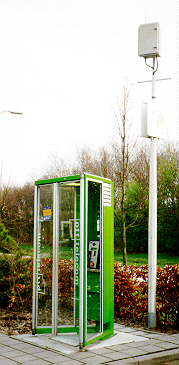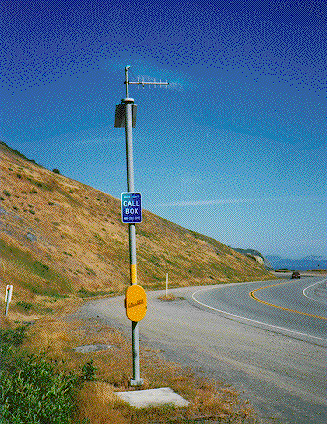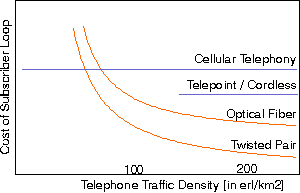
 |
Wireless CommunicationChapter: Business and Regulatory Aspects |

| For many decades, multiplexed communication channels (trunks) between switches with bundled traffic from many subscribers, were expensive and thus limited in capacity. From the 1950's, national PTTs established micr wave links to overcome the bandwidth and repeater-spacing limitations of coaxial trunk links. Nowadays, optical fibres offer capacity well in excess of what can be reached by any reasonable expansion of the micr wave radio relay network, and this technology is likely to dominate in all new trunk systems, though back-up radio systems are maintained to ensure reliability (particularly in regions with frequent earthquakes). |

|
Radio communication is has a much greater impact on the communication networks of today and in the future by providing local access for remote or mobile subscribers to the network. In most networks, about 50 to 70% of all investments in the telephone network is in the subscriber access loops. In the US alone, 65,049,600 tons of copper wire has been installed by the phone companies.
One of the most interesting promises of modern wireless communications is a lower initial cost of connecting each subscriber to the public network, largely independent of distance. The access technologies employed in digital cellular radio Personal Communication Systems (PCS) such as DECT and more full fledged wireless office systems (WOS) using broadband radio LANs, all offer interconnection with public networks at an investment which is mainly determined by the capacity required. This contrasts with the high initial investment of a hard wired local loop (whether optical or not), the cost of which increases dramatically in rural areas, roughly in inverse proportion
to the population density and required traffic capacity.

It is the perverse cost structure of the traditional hard wired access to public networks which caused 'market failure' to affect telephone penetration in many low traffic rural regions until now. This justified a local operating monopoly for public telephony in most European countries and the US. However, the novel wireless technologies may help avoiding any need to cross subsidize the local access from monopoly profits made elsewhere, because costs proportional to area capacity remove the classical market failure problem.
 | Figure: The cost of the subscriber loop in rural and sub-urban areas versus traffic density, for twisted pair (copper), optical fiber, cellular radio and cordless phones.. |
 Embedded QuickTime Video: The lastmile Cost of Local Loop
|  Audio
|
For wirebound access, the cost of a wired subscriber loop is more or less proportional to the distance between the local switch and the subscriber terminal, so it tends to decrease with the subscriber density. This is in contrast to the case for radio communication, where the cost of radio access does not significantly depend on the propagation distance or subscriber density.
In rural, thinly populated areas, radio communication therefore offers more economic subscriber loops than wired lines (probably including repeater/amplifiers) to every (remote) subscriber.
On the other hand, in residential areas, existing copper wires may remain more cost-effective than new radio access. However, new optical loops may eventually become competitive to installing or refurbishing the copper wire loop, particularly if the telephone network is integrated with networks for other services.
Networks for broadband interactive multimedia services are likely to face a more difficult market introduction. Most such services are not yet known to the public at large. In the past, it appeared difficult to introduce new technology (in new infrastructures) and new services at the same time. As wireless access does not have a cost structure that highly depends on spatial user densities, it may be feasible to start such services with a 'thin' wireless infrastructure.